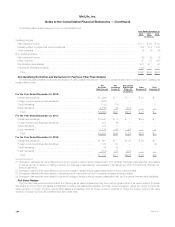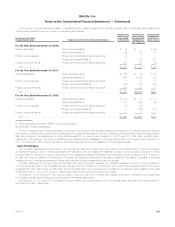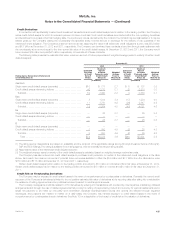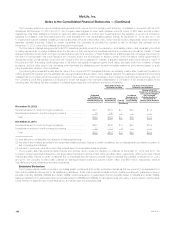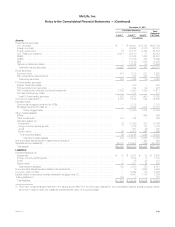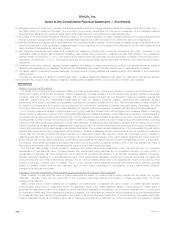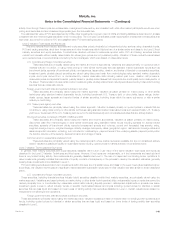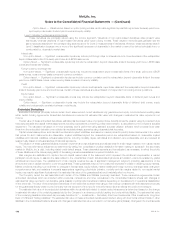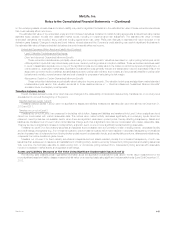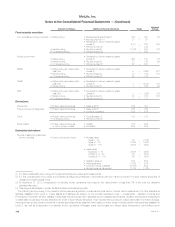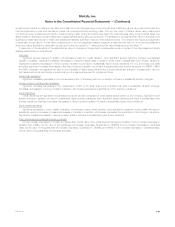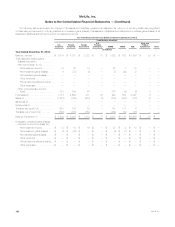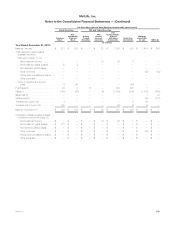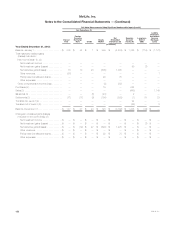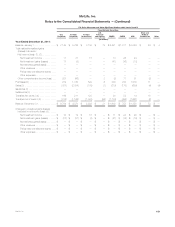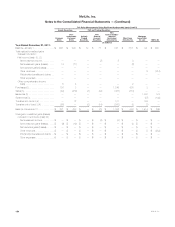MetLife 2012 Annual Report Download - page 150
Download and view the complete annual report
Please find page 150 of the 2012 MetLife annual report below. You can navigate through the pages in the report by either clicking on the pages listed below, or by using the keyword search tool below to find specific information within the annual report.
MetLife, Inc.
Notes to the Consolidated Financial Statements — (Continued)
Structured securities comprised of RMBS, CMBS and ABS
These securities are principally valued using the market and income approaches. Valuation is based primarily on matrix pricing, discounted cash
flow methodologies or other similar techniques that utilize inputs that are unobservable or cannot be derived principally from, or corroborated by,
observable market data, including spreads over below investment grade curves to reflect industry trends on specific credit-related issues. Below
investment grade securities, alternative residential mortgage loan RMBS and sub-prime RMBS included in this level are valued based on inputs
including quoted prices for identical or similar securities that are less liquid and based on lower levels of trading activity than securities classified in
Level 2. Certain of these valuations are based on independent non-binding broker quotations.
Common and non-redeemable preferred stock
These securities, including privately held securities and financial services industry hybrid securities classified within equity securities, are principally
valued using the market and income approaches. Valuations are based primarily on matrix pricing, discounted cash flow methodologies or other
similar techniques using inputs such as comparable credit rating and issuance structure. Certain of these securities are valued based on inputs
including quoted prices for identical or similar securities that are less liquid and based on lower levels of trading activity than securities classified in
Level 2 and independent non-binding broker quotations.
Mortgage Loans, MSRs and Liability Related to Securitized Reverse Residential Mortgage Loans
The Company has elected the FVO for commercial mortgage loans held by CSEs, certain residential mortgage loans held-for-sale, securitized
reverse residential mortgage loans, MSRs and the liability related to securitized reverse residential mortgage loans. Although MSRs are not financial
instruments, the Company has included them in the preceding table as a result of its election to carry them at estimated fair value.
Level 2 Valuation Techniques and Key Inputs:
Commercial Mortgage Loans Held by CSEs
These investments are principally valued using the market approach. The principal market for these investments is the securitization market. The
Company uses the quoted securitization market price of the obligations of the CSEs to determine the estimated fair value of these commercial
loan portfolios. These market prices are determined principally by independent pricing services using observable inputs.
Mortgage Loans Held-For-Sale
Residential mortgage loans held-for-sale are principally valued using the market approach. For securitized reverse residential mortgage loans,
valuation is based primarily on readily available observable pricing for securities backed by similar fixed-rate loans. For other residential mortgage
loans held-for-sale, valuation is based primarily on readily available observable pricing for securities backed by similar loans. The unobservable
adjustments to such prices are insignificant.
Liability Related to Securitized Reverse Residential Mortgage Loans
The estimated fair value of this liability is based on quoted prices when traded as assets in active markets or, if not available, based on market
standard valuation methodologies consistent with the Company’s methods and assumptions used to estimate the fair value of comparable
financial instruments.
Level 3 Valuation Techniques and Key Inputs:
Mortgage Loans Held-for-Sale
For both securitized reverse residential mortgage loans held-for-sale and other residential mortgage loans held-for-sale, for which pricing for
securities backed by similar adjustable-rate loans is not observable, the estimated fair value is determined using unobservable independent broker
quotations or valuation models using significant unobservable inputs.
MSRs
MSRs, which are valued using an income approach, are carried at estimated fair value and have multiple significant unobservable inputs
including assumptions regarding estimates of discount rates, loan prepayments and servicing costs. Sales of MSRs tend to occur in private
transactions where the precise terms and conditions of the sales are typically not readily available and observable market valuations are limited. As
such, the Company relies primarily on a discounted cash flow model to estimate the fair value of the MSRs. The model requires inputs such as
type of loan (fixed vs. variable and agency vs. other), age of loan, loan interest rates and current market interest rates that are generally
observable. The model also requires the use of unobservable inputs including assumptions regarding estimates of discount rates, loan
prepayments and servicing costs.
Liability Related to Securitized Reverse Residential Mortgage Loans
The estimated fair value of this liability is based on quoted prices when traded as assets in less active markets or, if not available, based on
market standard valuation methodologies using unobservable inputs, consistent with the Company’s methods and assumptions used to estimate
the fair value of comparable financial instruments.
Separate Account Assets
Separate account assets are carried at estimated fair value and reported as a summarized total on the consolidated balance sheets. The
estimated fair value of separate account assets is based on the estimated fair value of the underlying assets. Assets within the Company’s separate
accounts include: mutual funds, fixed maturity securities, equity securities, derivatives, hedge funds, other limited partnership interests, short-term
investments and cash and cash equivalents.
144 MetLife, Inc.


